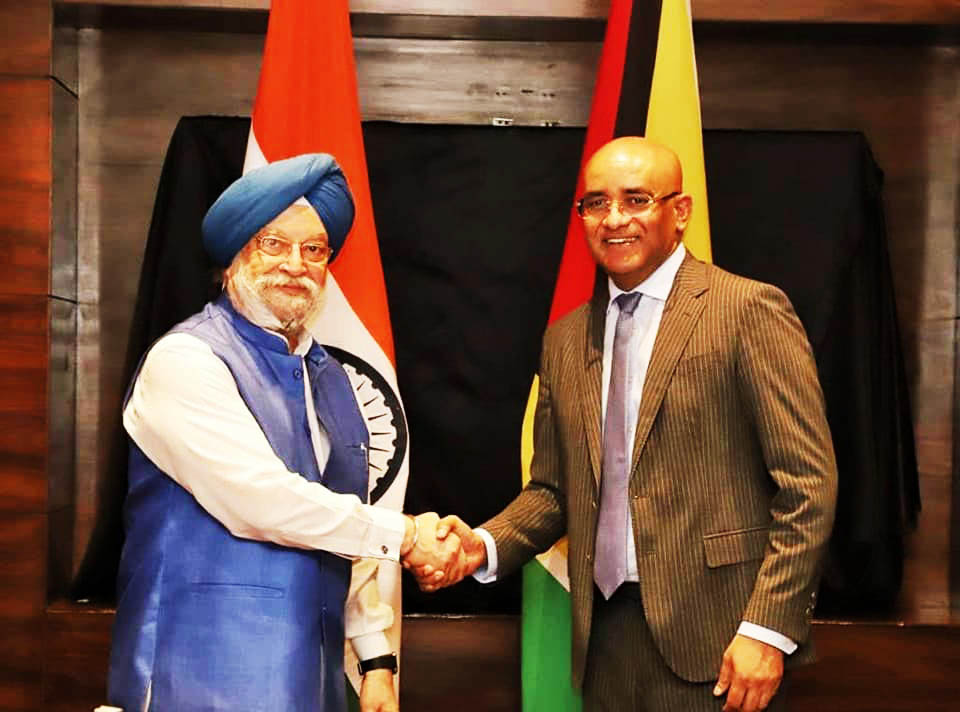There are unmistakable indications that the more than half a century of relatively staid relations between Guyana and India are seemingly set to shift gears, with conventional diplomatic ties associated mostly with their membership of the Commonwealth now, apparently, metamorphosing into a more pragmatic relationship born out of mutual recognition that, in practical terms, each of them possess resources that are important to the other. With India it is oil. Not that the country does not possess considerable oil resources of its own. When, however, a country is ranked as the third largest consumer of oil, globally, and given the multi-faceted complexity of the contemporary oil and gas industry, enough is really never enough.
What oil has done for India/Guyana relations is to shift its axis from the staid pattern of diplomacy that has historically, been commonplace among member countries of the Commonwealth ‘club,’ to an agenda that is much more consistent with a more hard-nosed development agenda. For India, unmistakably, the ‘carrot’ is oil, its unmistakable public expression of interest going back to 2021 when it swept up the first ever consignment of ‘Liza light, sweet crude’ and afterwards never really stopped to ‘tie up’ a longer term oil supply deal with Guyana.
To India’s half a century plus of diplomatic relations with Guyana can be added much longer years of cultural ties which, it seems, has, in a profoundly practical way, now been thrown into the mix of the contemporary relationship.
New Delhi’s now seemingly closed oil deal with Guyana is not an ‘accomplishment’ that it would take lightly.
The vicissitudes of a global oil industry, recently made worse by Russia’s military adventure in the Ukraine, coupled with India’s differences with Saudi Arabia over issues to do with global oil availability means that the country’s overwhelmingly oil-driven economy would not wish to look the Guyana ‘gift horse’ in the mouth. Analysts of relations between Guyana and India, specifically the seamless thread of close communication between the two countries since the 2021 ‘first Guyana oil sale’ are almost certainly less than surprised over what now seems to be the two countries signing on to a much bigger deal.
Recall that both President Irfaan Ali and his Vice President and ‘oil Czar,’ Bharrat Jagdeo have, in relatively recent months, both made highly publicized visits to India. Whatever else may have been the primary mission of the two ‘senior men’ journeying to India within a remarkably short period of time, India appeared to be working to a ‘tunnel-vision’ agenda. So that when, back in January, it was announced that Guyana was preparing to receive a proposal from India for long-term oil purchases, no one who had been carefully ‘reading the tea leaves’ would have been in the least bit surprised. More recently, it was Vice President Bharrat Jagdeo, who, shortly after his return from a visit to India in February, announced at a media briefing that bilateral deals on oil sales and other forms of energy sector cooperation between Guyana and India were ‘nailed down.’
He went further, asserting that extended industrial and business ties with India will also extend into the agricultural sector, specifically, into the country’s long anaemic sugar industry. During the media briefing, Jagdeo told the assembled representatives of the local media houses that the agreement with India extended in having its sugar experts (India has a long had a successful history in sugar cane that goes back to its period as a colony of Britain) come to Guyana where their wide-ranging technical expertise is to be pressed into service in an effort a salvage a sector which, truth be told, had long been ‘written off’ by many Guyanese even before they had turned their attention to the country’s new-found ‘oil bonanza.’
That said, the government has been only too well aware that while the advent of an oil and gas sector might well push sugar to the point of raising the chorus of its last hurrah, such a development could both impact tellingly on employment levels and have knock-on political ones. Sugar survives! For the political administration that would hardly have been too difficult a decision to make. That said, Vice President Jagdeo appeared to spare no pains seeking to make the case for cooperation with India in pursuit of the revival of the local sugar industry, alluding to India’s technical credentials in the sector, as well as its highly regarded agronomic culture.
His unmistakably ‘hard sell’ approach alluded to varieties of cane used in the Indian sugar industry that will “give you probably two to three times the output compared to what we are getting from a single acre of cane here” adding that Guyana is now going to “with India to expand our tissue culture facilities in a major way………..It would be a big boost to our cane farming industry,” he added.





